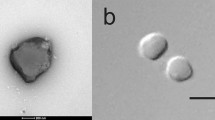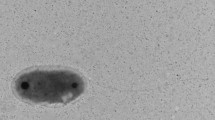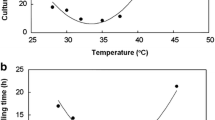Abstract
Seven members of a new group of rod-shaped hyperthermophilic neutrophilic archaebacteria were isolated from boiling neutral to alkaline solfataric waters from the Azores, Iceland, and Italy. The organisms are strict anaerobes, growing optimally at 100°C. The cells are motile due to peritrichous or bipolar polytrichous flagellation. The isolates grow facultatively chemolithoautotrophically or obligately heterotrophically. Molecular hydrogen or complex organic substances are used as electron donors. During heterotrophic growth, elemental sulfur, thiosulfate, sulfite, l(-)cystine and oxidized glutathione may serve as electron acceptors depending on the individual strain. Elemental sulfur is strictly required as an electron acceptor for autotrophic growth. The G+C content of the DNA is around 46 mol%. The isolates represent a new genus which we have named Pyrobaculum (the “fire stick”). Two species are described: the facultatively autotrophic Pyrobaculum islandicum (DSM 4184), which is the type species, and the obligately heterotrophic Pyrobaculum organotrophum (DSM 4185).
Similar content being viewed by others
References
Allen MB (1959) Studies with Cyanidium caldarium, an anomalously pigmented chlorophyte. Arch Mikrobiol 32:270–277
Balch WE, Wolfe RS (1976) New approach to the cultivation of methanogenic bacteria: 2-mercaptoethanesulfonic acid (HSCoM)-dependent growth of Methanobacterium ruminantium in a pressurized atmosphere. Appl Environ Microbiol 32:781–791
Balch WE, Fox GE, Magrum LJ, Woese CR, Wolfe RS (1979) Methanogens: Reevaluation of a unique biological group. Microbiol Rev 43:260–296
Birnstiel ML, Sells BH, Purdom IF (1972) Kinetic complexity of RNA molecules. J Mol Biol 63:21–39
Brock TD (1978) Thermophilic microorganisms and life at high temperatures. Springer, Berlin Heidelberg New York
Fiala G, Stetter KO (1986) Pyrococcus furiosus sp. nov. represents a novel genus of marine heterotrophic archaebacteria growing optimally at 100°C. Arch Microbiol 145:56–61
Fiala G, Stetter KO, Jannasch HW, Langworthy TA, Madon J (1986) Staphylothermus marinus sp. nov. represents a novel genus of extremely thermophilic submarine heterotrophic archaebacteria growing up to 98°C. Syst Appl Microbiol 8:106–113
Fischer F, Zillig W, Stetter KO, Schreiber G (1983) Chemolithoautotrophic metabolism of anaerobic extremely thermophilic archaebacteria. Nature 301:511–513
Gillespie S, Gillespie D (1971) Ribonucleic acid-deoxyribonucleic acid hybridization in aqueous solutions and in solutions containing formamide. Biochem J 125:481–487
Huber R, Langworthy TA, König H, Thomm M, Woese CR, Sleytr UB, Stetter KO (1986) Thermotoga maritima sp. nov. represents a new genus of unique extremely thermophilic eubacteria growing up to 90°C. Arch Microbiol 144:324–333
Huber R, Huber G, Segerer A, Seger J, Stetter KO (1987) Aerobic and anaerobic extremely thermophilic autotrophs. In: Verseveld HW, Duine JA (eds) Microbial growth on C1 compounds. Proceedings of the 5th International Symposium. Nijhoff, Dordrecht, pp 44–51
Kandler O (1982) Cell wall structures and their phylogenetic implications. Zbl Bakt Hyg I Abt Orig C 3:149–160
Kelly RB, Cozzarelli NR, Deutscher MP, Lehmann JR, Kornberg A (1970) Enzymatic synthesis of deoxyribonucleic acid. XXXII. Replication of duplex deoxyribonucleic acid by polymerase at a single strand break. J Biol Chem 245:39–45
Kessel M, Klink F (1982) Identification and comparison of eighteen archaebacteria by means of the diphtheria toxin reaction. Zbl Bakt Hyg I Abt Orig C 3:140–148
König H (1984) Isolation and characterization of Methanobacterium uliginosum sp. nov. from a marshy soil. Can J Microbiol 30:1477–1481
König H, Stetter KO (1982) Isolation and characterization of Methanolobus tindarius sp. nov., a coccoid methanogen growing only on methanol and methylamines. Zbl Bakt Hyg I Abt. Orig C 3:478–490
Langworthy TA (1982) Lipids of Thermoplasma. In: Colowick SP, Kaplan NO (eds) Methods in enzymology, vol 88. Academic Press, New York, pp 396–406
Marmur J, Doty P (1962) Determination of the base composition of deoxyribonucleic acid from its thermal denaturation temperature. J Mol Biol 5:109–118
Pfennig N, Bieb H (1976) Desulfuromonas acetoxidans gen. nov. and sp. nov., a new anaerobic, sulfur-reducing, acetate-oxidizing bacterium. Arch Microbiol 110:3–12
Pfennig N, Wagener S (1986) An improved method of preparing wet mounts for photomicrographs of microorganisms. J Microbiol Meth 4:303–306
Sleytr UB, Messner P (1983) Crystalline surface layers on bacteria. Ann Rev Microbiol 37:311–339
Stetter KO (1982) Ultrathin mycelia-forming organisms from submarine volcanic areas having an optimum growth temperature of 105°C. Nature 300:258–260
Stetter KO, Thomm M, Winter J, Wildgruber G, Huber H, Zillig W, Janecovic D, König H, Palm P, Wunderl S (1981) Methanothermus fervidus, sp. nov., a novel extremely thermophilic methanogen isolated from an Icelandic not spring. Zbl Bakt Hyg Abt I Orig C 2:166–178
Stetter KO, König H, Stackebrandt E (1983) Pyrodictium gen nov., a new genus of submarine disc-shaped sulphur-reducing archaebacteria growing optimally at 105°C. Syst Appl Microbiol 4:535–551
Stetter KO, Fiala G, Huber R, Huber G, Segerer A (1986) Life above the boiling point of water? Experientia 42:1187–1191
Williams WJ (1979) Handbook of anion determination. Butterworths, London, pp 570–572
Woese CR, Magrum LJ, Fox GE (1978) Archaebacteria. J Mol Evol 11:245–252
Zillig W, Stetter KO, Schulz W, Janekovic D (1980a) Comparative studies of structure and function of DNA-dependent RNA polymerases from eubacteria and archaebacteria. In: Mildner P, Rieds B (eds) Enzyme regulation and mechanism of action. Pergamon Press, Oxford New York, pp 159–178
Zillig W, Stetter KO, Wunderl S, Schulz W, Priess H, Scholz I (1980b) The Sulfolobus-“Caldariella”-group: Taxonomy on the basis of the structure of DNA-dependent RNA polymerases. Arch Microbiol 125:259–269
Zillig W, Stetter KO, Schäfer W, Janekovic D, Wunderl S, Holz I, Palm P (1981) Thermoproteales: A novel type of extremely thermoacidophilic anaerobic archaebacteria isolated from Icelandic solfataras. Zbl Bakt Hyg Abt I Orig C 2:205–227
Zinder S, Brock TD (1977) Sulfur dioxide in geothermal waters and gases. Geochim Cosmochim Acta 41:73–79
Author information
Authors and Affiliations
Rights and permissions
About this article
Cite this article
Huber, R., Kristjansson, J.K. & Stetter, K.O. Pyrobaculum gen. nov., a new genus of neutrophilic, rod-shaped archaebacteria from continental solfataras growing optimally at 100°C. Arch. Microbiol. 149, 95–101 (1987). https://doi.org/10.1007/BF00425072
Received:
Accepted:
Issue Date:
DOI: https://doi.org/10.1007/BF00425072




